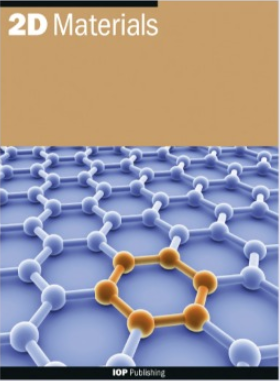来自天然硅酸盐的顺磁性二维氧化硅
IF 4.3
3区 材料科学
Q2 MATERIALS SCIENCE, MULTIDISCIPLINARY
引用次数: 0
摘要
二氧化硅具有磁性能的潜力令人着迷,因为将其电子功能与磁性响应相结合似乎很有希望用于自旋电子学。在这项研究中,我们探索了从纯硅酸盐(如二氧化硅)中的二磁行为到掺杂过渡金属的硅酸盐(如红柱石硅酸盐(CaMn3Mn(Si5O15))中的顺磁性行为的转变机制。通过液相可扩展剥离,这种天然存在的红柱石(R)硅酸盐在保持其磁性能的同时被减薄。通过 LPE 将 R 硅酸盐剥离成二维(2D)结构可提高磁矫顽力和退磁内阻(ΔHc),最高可达 ∼23.95 Oe,而其体相仅为 7.08 Oe。DFT 自旋极化计算证实了这些发现,并解释了磁矩的来源主要来自掺杂二维硅酸盐中的锰,这是因为价带中的锰 d 态和硅 p 态存在不对称成分。自旋分量差电荷密度进一步说明了这一结果,表明锰原子和硅原子显示出残余的上自旋电荷。红柱石不寻常的磁性行为在自旋电子学、数据存储和传感技术方面具有相当大的潜力。了解硅酸盐的结构、磁性和电子特性之间的复杂关系对于开发新材料和复合材料以及推动未来研究至关重要。本文章由计算机程序翻译,如有差异,请以英文原文为准。
Paramagnetic two-dimensional silicon-oxide from natural silicates
Silicon dioxide’s potential for having magnetic properties is fascinating, as combining its electronic capabilities with magnetic response seems promising for spintronics. In this work, the mechanisms that drive the change from diamagnetic behavior in pure silicates like SiO2 to paramagnetic behavior in transition metal-doped silicates like Rhodonite silicate (CaMn3Mn(Si5O15)) are explored. This naturally occurring Rhodonite (R)-silicate was thinned down while retaining its magnetic properties by liquid-phase scalable exfoliation. Exfoliating R-silicate into the two-dimensional (2D) structure by LPE increases magnetic coercivity, and the internal resistance to demagnetization (ΔHc) up to ∼23.95 Oe compared to 7.08 Oe for its bulk phase. DFT spin-polarized calculations corroborate those findings and explain that the origin of the magnetic moment comes mainly from the Mn in the doped 2D silicate due to the asymmetrical components of the Mn d and Si p states in the valence band. This result is further illustrated by the spin component differential charge densities showing that Mn and Si atoms display a residual up spin charge. Rhodonite’s unusual magnetic behavior has considerable potential for spintronics, data storage, and sensing technologies. Understanding the complex relationships between the structural, magnetic, and electronic properties of silicates is essential for developing new materials and composites as well as for driving future research.
求助全文
通过发布文献求助,成功后即可免费获取论文全文。
去求助
来源期刊

2D Materials
MATERIALS SCIENCE, MULTIDISCIPLINARY-
CiteScore
10.70
自引率
5.50%
发文量
138
审稿时长
1.5 months
期刊介绍:
2D Materials is a multidisciplinary, electronic-only journal devoted to publishing fundamental and applied research of the highest quality and impact covering all aspects of graphene and related two-dimensional materials.
 求助内容:
求助内容: 应助结果提醒方式:
应助结果提醒方式:


